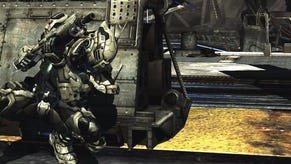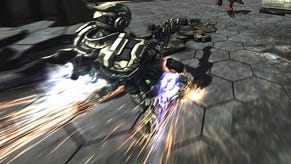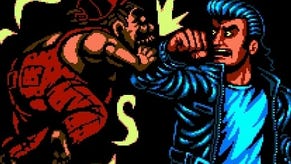PC Vanquish is every bit as good as you would hope
Higher resolutions and an unlocked frame-rate massively improve Platinum's last-gen classic.
Of all the games in Platinum's back catalogue, there was perhaps no other title in need of a re-release more than Vanquish. Even now, Shinji Mikami's take on third-person shooting stands as one of the most nuanced shooters ever made but the basic hardware limits of PlayStation 3 and Xbox 360 prevented it from reaching its full potential. Seven years on from its original release, the new PC version of Vanquish frees the title from its technical shackles - and the result is magnificent.
On its original platforms, Vanquish is an unsteady game at best. With the frame-rates hovering below 30fps during most battles, it never manages to feel especially smooth. Beyond that, the low 1024x720 resolution used by the game is at odds with its detailed visuals and sense of scale. In many ways, its basic technological make-up on last generation consoles feels at odds with the design of the game itself. The core design deserved better.
By releasing Vanquish on the PC, Platinum has been able to fully realise its potential at last. With the promise of uncapped frame-rates and ultra-high resolutions, the Vanquish experience is absolutely transformed. Clearly the ability to run the game at 60fps - or higher - is welcome. However, the visual improvements are more interesting than you might expect.
First impressions suggest a game with remastered, higher resolution art - hinted at in a PC options menu that does indeed have a high texture option - but in reality, that doesn't appear to be true for the most part. The textures are often small and tiled, but surfaces are razor sharp even on PS3. Essentially, with the low resolution of the game combined with low quality texture filtering it was never possible to fully appreciate the detail already present in the game.
Overall, when looking at both versions, the general sense is that the PC version basically wipes away a layer of Vaseline, revealing the true quality of Platinum's original assets - but this doesn't mean that there aren't a few genuine improvements. Platinum has added ambient occlusion to the visual mix, a welcome upgrade, but not exactly the most impressive implementation we've seen. What we did enjoy was the ability to remove LODs completely, meaning no geometry or texture 'pop' as higher quality models are swapped in as you move closer to them. A higher quality motion blur implementation is also appreciated.
The most significant improvements stems from shadows - it's possible to greatly increase shadow resolution on PC though shadows themselves are rendered differently. The console implementation is heavy filtered which helps hide artefacts but on PC, shadows are razor sharp, meaning that if you aren't running maxed here, there are some blocky artefacts.
Anti-aliasing is probably the weakest upgrade in the package - you get various forms of what is called 'Edge AA', but this doesn't appear to be multisampling. Standard FXAA is also included and while far from ideal, it seems to be the best option available (short of using GPU-level super-sampling). There aren't a lot of options here, but this is likely due to the engine. While Vanquish is based on Bayonetta's codebase to an extent, the team switched to a deferred renderer for this title which often presents issues, particularly with multi-sampling anti-aliasing.
There are a couple of extra options available outside of the menu that may be of interest. Using Steam's 'Set launch options' feature, you can use a pair of command line options. -Unlockaspectratio allows the game to draw the image outside of a 16:9 window - useful for ultra-wide monitors. The -fov command allows you to adjust field of view from 40 up to 120.
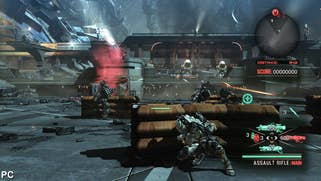

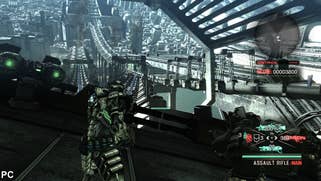
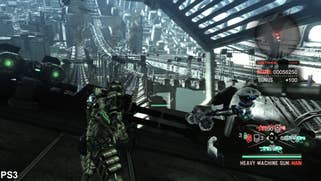
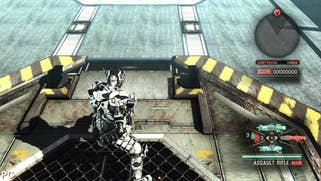
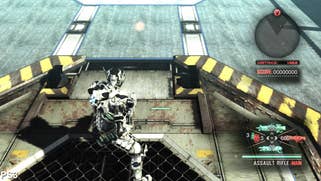
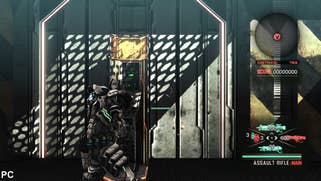
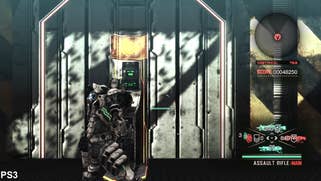
In some ways, Vanquish obviously remains a game of its time, relying heavily on pre-rendered cut-scenes rather than real-time sequences like Bayonetta. This means we're looking at 30fps, lower resolution videos to tell the story. Fortunately, on PC, the assets do appear to be higher quality. The video files are stored using the CRI Sofdec format at resolutions higher than what was visible on consoles - this includes weird resolutions such as 1920x1191. The point is, these scenes are at least sharper than on consoles, but still lower resolution than we'd like.
Of course, this also reveals something about the install size - the game requires more than 18GB to install but only 2.45GB of that is the game itself. The rest is taken up by video - 16GB of full-motion video sequences, to be precise. Still, outside of cut-scene playback, Vanquish really shines on the PC thanks to the higher resolution. The scenes were designed to convey a sense of scale but the low resolution of the original limited its impact. The higher resolution also allows you to more easily assess the battlefield making it easier to craft a plan of attack.
So, what kind of PC hardware do you need to get the job done? Bayonetta on PC was a delight in that you could run the game at 1080p at 60 frames per second on very modest hardware. Vanquish is an altogether different beast. At its stress points, a Core i5 processor can reach 70 per cent utilisation, but really it's the GPU that is your primary limiting factor here. Dropping in a budget GTX 750 Ti, the maxed out 1080p experience is typically in 30-40fps territory. Adjusting shadows and ambient occlusion to the normal setting brings this up to 50-60fps.
Next up, we tried Nvidia's GTX 1050 - a modern £100 graphics card. Maxed out, gameplay is mostly locked at 60fps, but screen-filling explosions during boss battles sees sharp drops in performance. Again, adjusting shadows and ambient occlusion helps here - but the rest of the settings have very limited impact on performance.
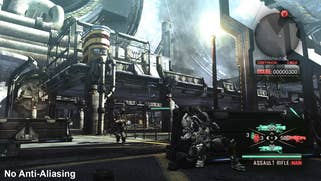
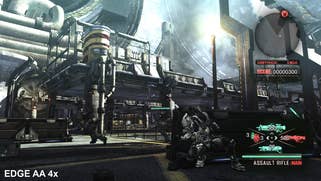
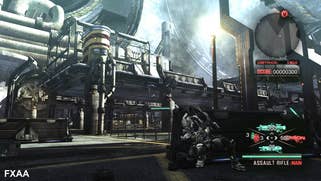
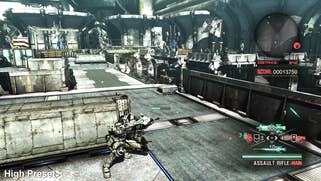
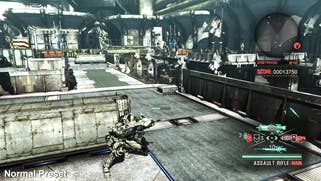
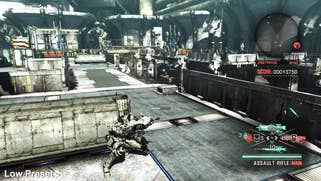
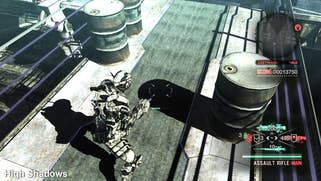
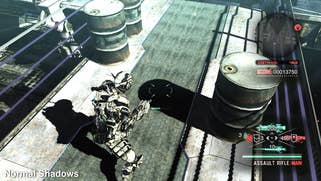
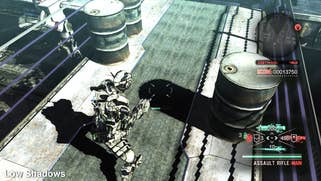
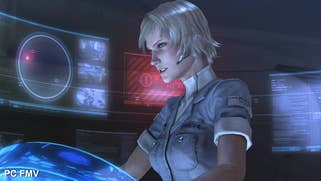
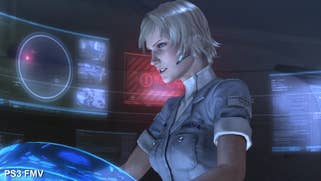
Moving up to the mainstream favourite - the GTX 970 - and there's a stratospheric leap in performance. You'll get 1080p gameplay at a minimum of 90fps, and you can lock to 60fps at 1440p with this hardware too - worth bearing in mind even for full HD display users, as super-sampling AA really is the way to gain the best image quality.
Moving up to GTX 980 Ti and GTX 1070-class hardware, and essentially this opens the door to native 4K gameplay at 60fps with all settings enabled. Performance is generally very stable throughout normal gameplay and it looks razor sharp. There are occasional exceptions to this, however, namely the first person walking sections which do drop frames as do some of the alpha explosions, but you're mostly looking at a stable level of performance.
Based on this small cross-section of hardware, it's clear that Vanquish is a more demanding game than Bayonetta and requires a mid-range PC to deliver a stable 60 frames per second. Nvidia hardware seems to suit the game engine more than AMD right now though - we also tested RX 480 and R9 Fury X on the AMD side. The RX 480 runs beautifully at 1080p as you would expect, but performance at 1440p isn't quite as solid at the 60fps mark as the GTX 970. Meanwhile, the Fury X operates at a significantly lower frame-rate than GTX 980 Ti and GTX 1070 running the game at 4K - 45fps in one boss battle vs 60fps on the Nvidia hardware. We would hope to see improvements here post-launch.
And that's really the key takeaway here. Based on our experiences with the PC version so far, the Vanquish experience has been elevated to the next level. The original console versions just don't hold up these days due to low performance and poor image quality, but gaming PCs today should have no issues powering through this lovely port. The game looks great, plays great and runs well. A genuine last-gen classic is enhanced in genuinely transformative ways on PC and we highly recommend you check it out.



